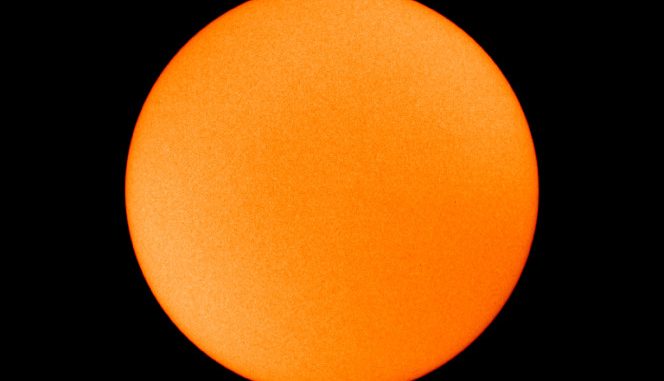
From the UNIVERSITY OF EXETER
The foundation of aquatic life can rapidly adapt to global warming, new research suggests
Important microscopic creatures which produce half of the oxygen in the atmosphere can rapidly adapt to global warming, new research suggests.
Phytoplankton, which also act as an essential food supply for fish, can increase the rate at which they take in carbon dioxide and release oxygen while in warmer water temperatures, a long-running experiment shows.
Monitoring of one species, a green algae, Chlamydomonas reinhardtii, after ten years of them being in waters of a higher temperature shows they quickly adapt so they are still able to photosynthesise more than they respire.
Phytoplankton use chlorophyll to capture sunlight, and photosynthesis to turn it into chemical energy. This means they are critical for reducing carbon dioxide in the atmosphere and for providing food for aquatic life.
It is crucial to know how these tiny organisms – which are not visible to the naked eye – react to climate change in the long-term. Experts had made predictions that that climate change would have negative effects on phytoplankton. But a new study shows green algae can adjust to warmer water temperatures. They become more competitive and increase the amount they are able to photosynthesise.
Algae examined by scientists which lived in warmer waters became fitter, and more competitive, proving that these tiny creatures adapt well to climate change. This suggests that this species could continue to be a plentiful source of food for aquatic life even if temperatures rise.
Previous studies which sought to answer this question have been conducted only in laboratories rather than looking at how phytoplankton reacted to real conditions. In contrast this research, which has run so far for ten years, has allowed researchers to examine how the green algae fare in their natural environment, where they are exposed to a more complex environment, and competitors.
SUN POWERING DOWN
The sun is currently blank with no visible sunspots and this is the 14th straight day with a blank look which is the longest such stretch since April 2010 according to spaceweather.com.
A blank look to the sun on Monday, March 20, and it has now been blank for two weeks straight; image courtesy NASA/GSFC
Historically weak solar cycle 24 continues to transition away from its solar maximum phase and towards the next solar minimum. In April 2010 – the last time there was a two week stretch with no visible sunspots – the sun was emerging from the last solar minimum which was historically long and deep. There have already been 26 spotless days in 2017 (34% of the entire year) and this follows 32 spotless days last year which occurred primarily during the latter part of the year. The blank look to the sun will increase in frequency over the next couple of years leading up to the next solar minimum – probably to be reached in late 2019 or 2020. By one measure, the current solar cycle is the third weakest since record keeping began in 1755 and it continues a weakening trend since solar cycle 21 peaked in 1980. One of the impacts of low solar activity is the increase of cosmic rays that can penetrate into the Earth’s upper atmosphere and this has some important consequences.
Comparison of all solar cycles since 1755 in terms of accumulated sunspot number anomalies from the mean value at this stage of the solar cycle. Plot courtesy publication cited below, authors Frank Bosse and Fritz Vahrenholt
Third weakest solar cycle since 1755
A recent publication has analyzed the current solar cycle and has found that when sunspot anomalies are compared to the mean for the number of months after cycle start, there have been only two weaker cycles since observations began in 1755. Solar cycle 24 began in 2008 after a historically long and deep solar minimum which puts us more than eight years into the current cycle. The plot (above) shows accumulated sunspot anomalies from the mean value after cycle start (97 months ago) and only solar cycles 5 and 6 had lower levels going all the way back to 1755. The mean value is noted at zero and solar cycle 24 is running 3817 spots less than the mean. The seven cycles preceded by solar cycle 24 had more sunspots than the mean.
RUSSIAN SCIENTISTS SEEING STRONG SIGNS OF GLOBAL COOLING ABOUT TO HIT
A new scientific paper authored by seven scientists affiliated with the Russian Academy of Sciences was just published in the scientific journal Bulletin of the Russian Academy of Sciences: Physics.
The scientists dismiss both “greenhouse gases” and variations in the Sun’s irradiance as significant climate drivers, and instead embrace cloud cover variations — modulated by cosmic ray flux — as a dominant contributor to climate change.
A concise summary: As cosmic ray flux increases, more clouds are formed on a global scale. More global-scale cloud cover means more solar radiation is correspondingly blocked from reaching the Earth’s surface (oceans). With an increase in global cloud cover projected for the coming decades (using trend analysis), a global cooling is predicted.
Dead zones may threaten coral reefs worldwide
SMITHSONIAN TROPICAL RESEARCH INSTITUTE
Dead zones affect dozens of coral reefs around the world and threaten hundreds more according to a new study by Smithsonian scientists published in Proceedings of the National Academy of Sciences. Watching a massive coral reef die-off on the Caribbean coast of Panama, they suspected it was caused by a dead zone–a low-oxygen area that snuffs out marine life–rather than by ocean warming or acidification.
“Ocean warming and acidification are recognized global threats to reefs and require large-scale solutions, whereas the newly recognized threats to coral reefs caused by dead zones are more localized, said Andrew Altieri, staff scientist at the Smithsonian Tropical Research Institute and first author of the study. Fortunately dead zones can be reduced by controlling sewage and agricultural runoff into the ocean.”
In September, 2010, coral reefs in Almirante Bay, Bocas del Toro Province, showed severe signs of stress. In addition to corals turning white and dying, which is typical during coral bleaching associated with warming events, there were other clues suggesting that more was involved than high temperatures. Many unusual observations pointed to something else as the culprit. There were thick mats of bacterial slime, and the dead bodies of crabs, sea urchins and sponges lay scattered on the ocean floor. Even more odd, there was a clear depth line above which the reefs looked OK, and below which, something had gone terribly wrong. Even single colonies of corals that straddled the line were fine above and dying below.
Scientists went to work, measuring several aspects of water quality. One set of measurements came back as a shock. Extremely low oxygen levels in deeper waters contrasted with high oxygen levels in shallow waters where corals were still healthy. This is the hallmark of a dead zone.
The team thinks that such dead zones may be common in the tropics but have gone largely unreported, simply because scientists never looked. “The number of dead zones currently on our map of the world is 10 times higher in temperate areas than it is in the tropics, but many marine biologists work out of universities in Europe and North America and are more likely to find dead zones close to home,” Altieri said.
“We were lucky that there was already a reef monitoring program in place at STRI’s Bocas del Toro Research Station as part of the Smithsonian’s Marine Global Earth Observatory Network,” said Rachel Collin, station director.
“Based on our analyses, we think dead zones may be underreported by an order of magnitude.” said Nancy Knowlton, coauthor and Sant Chair for Marine Science at the Smithsonian’s National Museum of Natural History. “For every one dead zone in the tropics, there are probably 10–nine of which have yet to be identified.”
The researchers found 20 instances when dead zones were implicated in the mass mortality of coral reefs worldwide. “Hypoxia (low oxygen) isn’t even mentioned in several of the most important academic reviews of threats to coral reefs and is rarely discussed at scientific meetings,” Altieri said, “Even worse, many coral-reef monitoring efforts do not include measurement of oxygen levels, making it nearly impossible to identify low oxygen as the cause of mass coral mortality after the fact.” For example, the cause of a 2016 mass mortality at the Flower Garden Reefs in the Gulf of Mexico remains unclear, but some of the photographs look strikingly similar to what was observed in Panama.
The authors argue that building capacity to monitor oxygen on reefs will help people to improve coral reef health and understand how dead zones might interact with other forces such as global warming in a one-two punch, which put reefs in even greater danger.
###
The Smithsonian Tropical Research Institute, headquartered in Panama City, Panama, is a part of the Smithsonian Institution. The Institute furthers the understanding of tropical nature and its importance to human welfare, trains students to conduct research in the tropics and promotes conservation by increasing public awareness of the beauty and importance of tropical ecosystems. Website. Promo video.
Andrew H. Altieri, Seamus Harrison, Janina Seeman, Rachel Collin, Robert J. Diaz, Nancy Knowlton . 2017. Tropical dead zones and mass mortalities on coral reefs. PNAS http://www.pnas.org/cgi/doi/10.1073/pnas.1621517114










